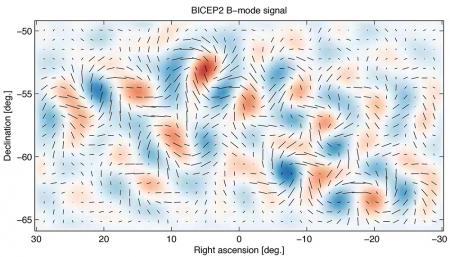
Credit: The BICEP2 Collaboration
Gravitational waves from inflation generate a faint but distinctive twisting pattern in the polarization of the CMB, known as a "curl" or B-mode pattern. Shown here is the actual B-mode pattern observed with the BICEP2 telescope, with the line segments showing the polarization from different spots on the sky. The red and blue shading shows the degree of clockwise and anti-clockwise twisting of this B-mode pattern.
|
ABSTRACT:
We report results from the BICEP2 experiment, a Cosmic Microwave Background (CMB) polarimeter specifically designed to search for the signal of inflationary gravitational waves in the B-mode power spectrum around l=80. The telescope comprised a 26 cm aperture all-cold refracting optical system equipped with a focal plane of 512 antenna coupled transition edge sensor (TES) 150 GHz bolometers each with temperature sensitivity of approx. 300 uk.sqrt(s). BICEP2 observed from the South Pole for three seasons from 2010 to 2012. A low-foreground region of sky with an effective area of 380 square degrees was observed to a depth of 87 nK-degrees in Stokes Q and U. In this paper we describe the observations, data reduction, maps, simulations and results. We find an excess of B-mode power over the base lensed-LCDM expectation in the range 30<l<150, inconsistent with the null hypothesis at a significance of >5σ. Through jackknife tests and simulations based on detailed calibration measurements we show that systematic contamination is much smaller than the observed excess. We also estimate potential foreground signals and find that available models predict these to be considerably smaller than the observed signal. These foreground models possess no significant cross-correlation with our maps. Additionally, cross-correlating BICEP2 against 100 GHz maps from the BICEP1 experiment, the excess signal is confirmed with 3σ significance and its spectral index is found to be consistent with that of the CMB, disfavoring synchrotron or dust at 2.3σ and 2.2σ, respectively. The observed B-mode power spectrum is well-fit by a lensed-LCDM + tensor theoretical model with tensor/scalar ratio r=0.20+0.07−0.05, with r=0 disfavored at 7.0σ. Subtracting the best available estimate for foreground dust modifies the likelihood slightly so that r=0 is disfavored at 5.9σ.
|
